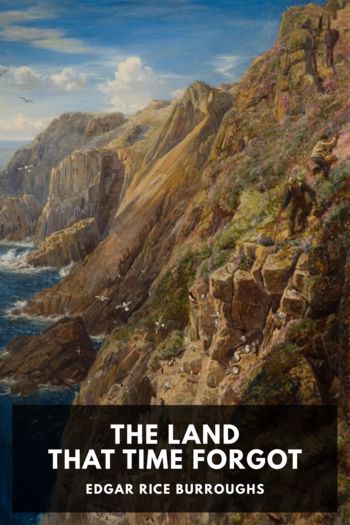South!, Ernest Shackleton [good books to read in english TXT] 📗

- Author: Ernest Shackleton
Book online «South!, Ernest Shackleton [good books to read in english TXT] 📗». Author Ernest Shackleton
During December 6 the Endurance made good progress on a southeasterly course. The northerly breeze had freshened during the night and had brought up a high following sea. The weather was hazy, and we passed two bergs, several growlers, and numerous lumps of ice. Staff and crew were settling down to the routine. Bird life was plentiful, and we noticed Cape pigeons, whale-birds, terns, mollymauks, nellies, sooty, and wandering albatrosses in the neighbourhood of the ship. The course was laid for the passage between Sanders Island and Candlemas Volcano. December 7 brought the first check. At six o’clock that morning the sea, which had been green in colour all the previous day, changed suddenly to a deep indigo. The ship was behaving well in a rough sea, and some members of the scientific staff were transferring to the bunkers the coal we had stowed on deck. Sanders Island and Candlemas were sighted early in the afternoon, and the Endurance passed between them at 6 p.m. Worsley’s observations indicated that Sanders Island was, roughly, three miles east and five miles north of the charted position. Large numbers of bergs, mostly tabular in form, lay to the west of the islands, and we noticed that many of them were yellow with diatoms. One berg had large patches of red-brown soil down its sides. The presence of so many bergs was ominous, and immediately after passing between the islands we encountered stream-ice. All sail was taken in and we proceeded slowly under steam. Two hours later, fifteen miles northeast of Sanders Island, the Endurance was confronted by a belt of heavy pack-ice, half a mile broad and extending north and south. There was clear water beyond, but the heavy southwesterly swell made the pack impenetrable in our neighbourhood. This was disconcerting. The noon latitude had been 57° 26′ S., and I had not expected to find pack-ice nearly so far north, though the whalers had reported pack-ice right up to South Thule.
The situation became dangerous that night. We pushed into the pack in the hope of reaching open water beyond, and found ourselves after dark in a pool which was growing smaller and smaller. The ice was grinding around the ship in the heavy swell, and I watched with some anxiety for any indication of a change of wind to the east, since a breeze from that quarter would have driven us towards the land. Worsley and I were on deck all night, dodging the pack. At 3 a.m. we ran south, taking advantage of some openings that had appeared, but met heavy rafted pack-ice, evidently old; some of it had been subjected to severe pressure. Then we steamed northwest and saw open water to the northeast. I put the Endurance’s head for the opening, and, steaming at full speed, we got clear. Then we went east in the hope of getting better ice, and five hours later, after some dodging, we rounded the pack and were able to set sail once more. This initial tussle with the pack had been exciting at times. Pieces of ice and bergs of all sizes were heaving and jostling against each other in the heavy southwesterly swell. In spite of all our care the Endurance struck large lumps stem on, but the engines were stopped in time and no harm was done. The scene and sounds throughout the day were very fine. The swell was dashing against the sides of huge bergs and leaping right to the top of their icy cliffs. Sanders Island lay to the south, with a few rocky faces peering through the misty, swirling clouds that swathed it most of the time, the booming of the sea running into ice-caverns, the swishing break of the swell on the loose pack, and the graceful bowing and undulating of the inner pack to the steeply rolling swell, which here was robbed of its break by the masses of ice to windward.
We skirted the northern edge of the pack in clear weather with a light southwesterly breeze and an overcast sky. The bergs were numerous. During the morning of December 9 an easterly breeze brought hazy weather with snow, and at 4:30 p.m. we encountered the edge of pack-ice in lat. 58° 27′ S., long. 22° 08′ W. It was one-year-old ice interspersed with older pack, all heavily snow-covered and lying west-southwest to east-northeast. We entered the pack at 5 p.m., but could not make progress, and cleared it again at 7:40 p.m. Then we steered east-northeast and spent the rest of the night rounding the pack. During the day we had seen adelie and ringed penguins, also several humpback and finner whales. An ice-blink to the westward indicated the presence of pack in that direction. After rounding the pack we steered S. 40° E., and at noon on the 10th had reached lat. 58° 28′ S., long. 20° 28′ W. Observations showed the compass variation to be 1½° less than the chart recorded. I kept the Endurance on the course till midnight, when we entered loose open ice about ninety miles southeast of our noon position. This ice proved to fringe the pack, and progress became slow. There was a long easterly swell with a light northerly breeze, and the weather was clear and fine. Numerous bergs lay outside the pack.
The Endurance steamed through loose open ice till 8 a.m. on the 11th, when we entered the pack in lat. 59° 46′ S., long. 18° 22′ W. We could have gone farther east, but the pack extended far in that direction, and an effort to circle it might have involved a lot of northing. I did not wish to lose the benefit of the original southing. The extra miles would not have





Comments (0)